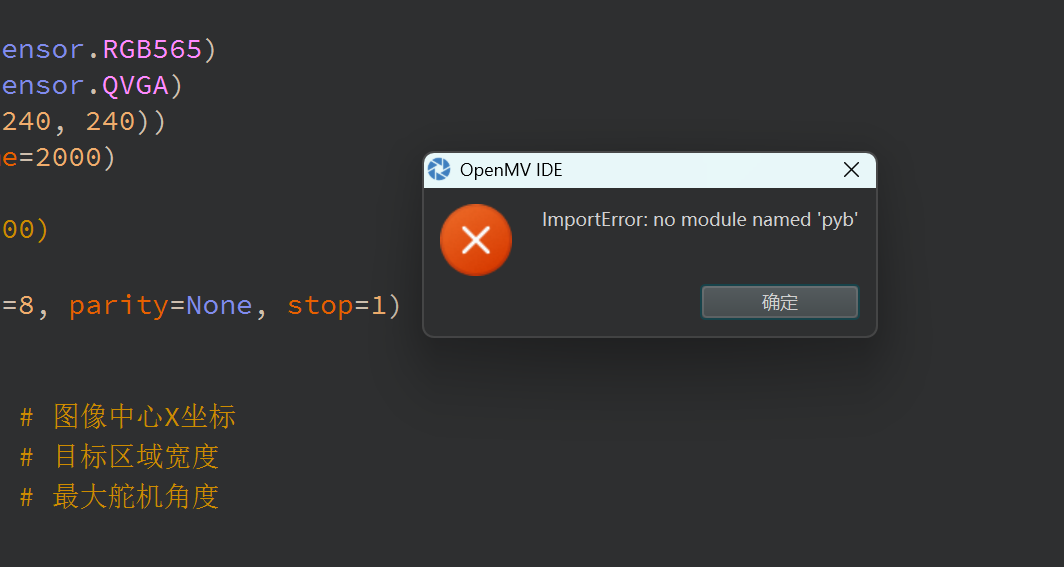open MV与STM32控制板连接进行UART串口通讯,但是IDE中运行报错没有pyb模块是什么原因?
-
# OpenMV Object Tracking with UART Communication to STM32 (保持目标检测显示不变) # # This work is licensed under the MIT license. # Copyright (c) 2013-2024 OpenMV LLC. All rights reserved. import sensor, image, time, ml, math, uos, gc from pyb import UART import pyb # 初始化摄像头 sensor.reset() sensor.set_pixformat(sensor.RGB565) sensor.set_framesize(sensor.QVGA) sensor.set_windowing((240, 240)) sensor.skip_frames(time=2000) # 初始化UART (波特率115200) uart = UART(3, 115200) uart.init(115200, bits=8, parity=None, stop=1) # 目标区域设置 TARGET_CENTER_X = 120 # 图像中心X坐标 TARGET_WIDTH = 20 # 目标区域宽度 MAX_SERVO_ANGLE = 45 # 最大舵机角度 # 数据包格式定义 HEADER = 0xAA # 数据包头 FOOTER = 0x55 # 数据包尾 # 加载模型和标签 (保持不变) net = None labels = None min_confidence = 0.5 try: net = ml.Model("trained.tflite", load_to_fb=uos.stat('trained.tflite')[6] > (gc.mem_free() - (64*1024))) except Exception as e: raise Exception('Failed to load model: ' + str(e)) try: labels = [line.rstrip('\n') for line in open("labels.txt")] except Exception as e: raise Exception('Failed to load labels: ' + str(e)) # 颜色定义 colors = [ (255, 0, 0), (0, 255, 0), (255, 255, 0), (0, 0, 255), (255, 0, 255), (0, 255, 255), (255, 255, 255) ] threshold_list = [(math.ceil(min_confidence * 255), 255)] # 后处理函数 def fomo_post_process(model, inputs, outputs): ob, oh, ow, oc = model.output_shape[0] x_scale = inputs[0].roi[2] / ow y_scale = inputs[0].roi[3] / oh scale = min(x_scale, y_scale) x_offset = ((inputs[0].roi[2] - (ow * scale)) / 2) + inputs[0].roi[0] y_offset = ((inputs[0].roi[3] - (ow * scale)) / 2) + inputs[0].roi[1] l = [[] for i in range(oc)] for i in range(oc): img = image.Image(outputs[0][0, :, :, i] * 255) blobs = img.find_blobs(threshold_list, x_stride=1, y_stride=1, area_threshold=1, pixels_threshold=1) for b in blobs: rect = b.rect() x, y, w, h = rect score = img.get_statistics(thresholds=threshold_list, roi=rect).l_mean() / 255.0 x = int((x * scale) + x_offset) y = int((y * scale) + y_offset) w = int(w * scale) h = int(h * scale) l[i].append((x, y, w, h, score)) return l def send_angle_to_stm32(angle): """发送角度数据给STM32 (二进制协议)""" angle_int = int(angle * 100) # 转换为0.01度单位 data = bytearray([ HEADER, (angle_int >> 8) & 0xFF, # 角度高字节 angle_int & 0xFF, # 角度低字节 FOOTER ]) uart.write(data) # print("Sent:AA %02X %02X 55 (Angle=%.2f°)" % (data[1],data[2],angle)) def calculate_servo_angle(target_x): """计算舵机角度""" angle = (target_x - TARGET_CENTER_X) * (MAX_SERVO_ANGLE / TARGET_CENTER_X) angle = max(-MAX_SERVO_ANGLE, min(MAX_SERVO_ANGLE, angle)) print("Servo angle requireed:{:.2f}".format(angle)) return angle clock = time.clock() while True: clock.tick() img = sensor.snapshot() # 绘制目标区域 img.draw_rectangle((TARGET_CENTER_X-TARGET_WIDTH//2, 0, TARGET_WIDTH, img.height()), color=(0, 255, 0)) detected_objects = [] # 目标检测逻辑 for i, detection_list in enumerate(net.predict([img], callback=fomo_post_process)): if i == 0 or len(detection_list) == 0: continue print(f"----- {labels[i]} -----") for x, y, w, h, score in detection_list: center_x = math.floor(x + w/2) center_y = math.floor(y + h/2) detected_objects.append((center_x, center_y, score)) # 绘制逻辑 img.draw_circle((center_x, center_y, 12), color=colors[i]) img.draw_string(x, y-10, f"{score:.2f°}", color=colors[i]) # 如果有检测到目标,计算平均位置 if detected_objects: # 加权平均计算 total_weight = sum(score for _, _, score in detected_objects) avg_x = sum(x*score for x, _, score in detected_objects) / total_weight # 计算角度并打印 angle = calculate_servo_angle(avg_x) # 计算角度并发送给STM32 angle = calculate_servo_angle(avg_x) send_angle_to_stm32(angle) # # 模拟目标位置(中心右侧30像素) # test_x = TARGET_CENTER_X + 30 # test_angle = (test_x - TARGET_CENTER_X) * (MAX_SERVO_ANGLE / TARGET_CENTER_X) # # 发送虚拟数据 # send_angle_to_stm32(test_angle) # # 保持可视化(可选) # img.draw_cross(int(test_x), 120, color=(255,0,0), size=20) # img.draw_string(10, 10, "调试模式: Angle=%.1f°" % test_angle) # time.sleep_ms(100) # 控制输出频率 img.draw_cross(int(avg_x), color=(255, 0, 0), size=20) img.draw_string(10, 10, f"Target: {int(avg_x)}", color=(255, 255, 255)) img.draw_string(10, 25, f"Angle: {angle:.1f}°", color=(255, 255, 255)) print(f"FPS: {clock.fps():.1f}\n")
-
你使用的是什么硬件?